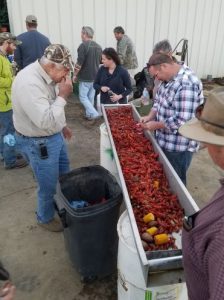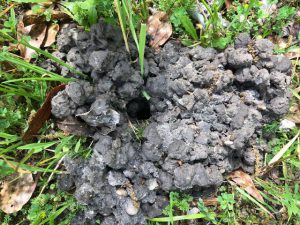
“You get a line, I’ll get a pole, we’ll go down to the crawdad hole, honey, baby, mine“…there are lots of great zydeco songs singing the praises of crawfish (aka crayfish, crawdads, mudbugs). They are in season now, and while crawfish festivals all around the southeast are canceled due to concerns over COVID-19, they are still available and make for great eating. Most of us would recognize a cooked one alongside a feast of corn and potatoes, but would you know an actual crawfish hole if you came up on it?
Last fall, our office welcomed about 500 kids (over several days) to the 4-H camp in Barrineau Park for a field trip. I showed every single one of them a small muddy mound with an opening in the top, and asked if anyone could tell me what it was. Not a single kid knew! Now, I make sure I point crawfish mounds out to anyone I happen to be walking with, as they are fascinating little structures. Also referred to as crawfish chimneys due to their upright, open construction, they are built by a crawfish in a muddy area, often near a creek or other water source.

The industrious invertebrate uses its legs and mouth to create pellets of mud as it digs its burrow. It places mud up above the ground, using the mud balls like small bricks. Bricking up the entrance to its burrow (as opposed to placing discarded mud elsewhere) also protects a crawfish from exposure to predators on open soil. The crawfish chimneys connect down to a burrow that may reach 3 feet deep, some straight down and others with side tunnels extending different directions. Since the crawfish lives in wetland areas, it is theorized that these chimneys extending above the soil allow for better oxygen flow in the burrow. During a drought, crawfish will plug the opening of their mounds with mud, to keep water in the burrow from evaporating.
Crawfish in the wild are rarely harvested, although some folks do fish for them like the song referenced earlier. For the vast majority of crawfish harvested in commercial production, two species are the most popular–the white river crawfish (Procambarus zonangulus) and red swamp crawfish (Procambarus clarkii). They are typically farmed in coordination with rice, as both commodities thrive in flooded conditions. Most aquaculture operations are associated with Louisiana, but at least five other southern U.S. states farm crawfish. To learn more about this industry, check out LSU AgCenter’s informative video.
 3
3
